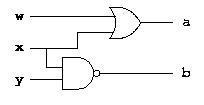
A truth table is a complete enumeration of all possible combinations of input values, each one with its associated output value.

All we need to do to establish a truth table for this circuit is to compute the output value for the circuit for each possible combination of input values. We obtain the following truth table:
w x y | a b ----------- 0 0 0 | 0 1 0 0 1 | 0 1 0 1 0 | 1 1 0 1 1 | 1 0 1 0 0 | 1 1 1 0 1 | 1 1 1 1 0 | 1 1 1 1 1 | 1 0
For instance, let us suppose we want a circuit of four inputs, interpreted as two nonnegative binary integers of two binary digits each, and two outputs, interpreted as the nonnegative binary integer giving the quotient between the two input numbers. Since division is not defined when the denominator is zero, we do not care what the output value is in this case. Of the sixteen entries in the truth table, four have a zero denominator. Here is the truth table:
x1 x0 y1 y0 | z1 z0 ------------------- 0 0 0 0 | - - 0 0 0 1 | 0 0 0 0 1 0 | 0 0 0 0 1 1 | 0 0 0 1 0 0 | - - 0 1 0 1 | 0 1 0 1 1 0 | 0 0 0 1 1 1 | 0 0 1 0 0 0 | - - 1 0 0 1 | 1 0 1 0 1 0 | 0 1 1 0 1 1 | 0 0 1 1 0 0 | - - 1 1 0 1 | 1 1 1 1 1 0 | 0 1 1 1 1 1 | 0 1Unspecified output values like this can greatly decrease the number of circuits necessary to build the circuit. The reason is simple: when we are free to choose the output value in a particular situation, we choose the one that gives the fewest total number of gates.
For the purpose of this course, we don't care about minimality. It might be conceptually advantageous still to indicate outputs with arbitrary values.